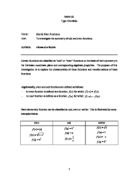Method: Discover how to solve inverse functions both graphically and algebraically, whilst investigating their relations, properties and patterns.
2.
a)
The linear function, f(x) = 2x + 4 is reflected. So the points on the graph, (0,4) become (4,0).
b)
(3x - 1)/(x + 2) is reflected and becomes, (2x + 1)/(3 – x). This results in a mirror image of the original function.
c)
f(x) = x³ is reflected resulting in the inverse function, g(x) = ³√x.
3.
Using the linear function, f(x) = 4x + 8, it is clear that my results in Q2 are indeed correct, as they are confirmed by the inverse function of the above linear function. It is flipped resulting in g(x) =. I worked out the inverse function by working out the slope and the y-intercept and then plotting those points on the graph.
4.
I used the mirror image of y = x to graphically work out the inverse function of ⅕2
5. Although all linear functions have an inverse function and rational functions have an inverse of a rational function, quadratic functions fail the vertical line test. This results in the equation y = x² not having an inverse function, as can be seen in the graph below.
Discussion: I have discovered that the inverse of a function is found by using the mirror image of the original function. This results in the points on the graph flip, resulting the points (4,2) becoming (2,4).
This can be shown algebraically, by simply swapping the values of x and y. ˛˙ ̧ y = 2 and x = 4, becomes, y = 4 and x = 2. To prove this method, we use the f(g(x)) method. Once f(g(x)) = x, we can prove that the equation has an inverse function. Using the methods, y = x and the function f(x) has an inverse f¯¹ (x) if f (f¯¹ (x)) = x, I have been able to solve the functions and work out their inverse function.
This only works with linear functions, (the inverse of a linear function is also a linear function) and rational functions, as the inverse of a squared number is a square root which cannot be used because it fails the vertical line test.
Algebraically, this can proven by showing that the inverse of y = x², is y = √x. This is due to the fact that the inverse function is in fact a mirror image of the f(x). However, as each y value has more than one x value, it cannot be a function.
Conclusion: By completing this investigation, I have been able to find out that all linear and rational functions have an inverse. However, the same cannot be said about quadratic functions because it does not fulfil the criterion of a inverse function, that each y value cannot have more than one x value. All functions that complete the vertical line test will have an inverse function.







